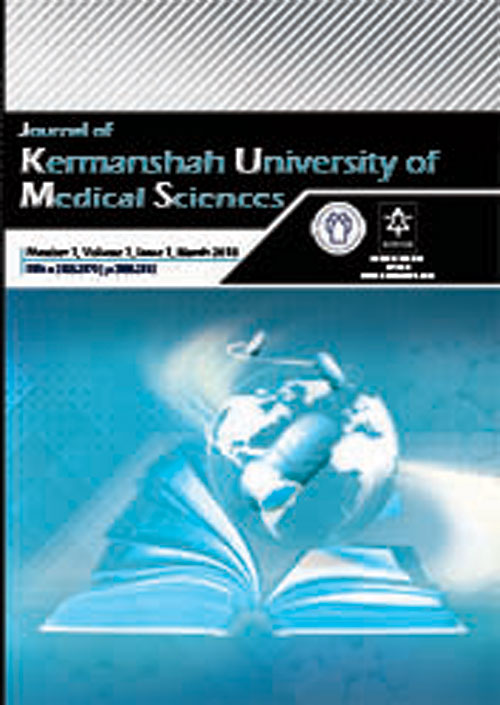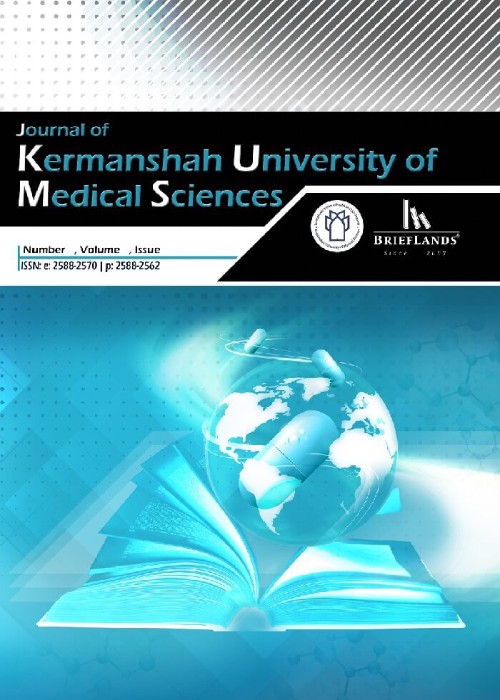فهرست مطالب

Journal of Kermanshah University of Medical Sciences
Volume:23 Issue: 1, Mar 2019
- تاریخ انتشار: 1398/01/17
- تعداد عناوین: 7
-
-
Page 1BackgroundCertain scales have been designed to measure fear of happiness as a phenomenon that is observed in different cultures.ObjectivesThe present study was conducted to investigate the psychometric properties of the fear of happiness scale in an Iranian sample, and to study this phenomenon in the Iranian culture.MethodsA total of 210 students of Kermanshah University of Medical Sciences, Kermanshah, Iran, including 83 males and 127 females, completed the fear of happiness scale (FHS), the mindful attention awareness scale (MAAS), the fear of negative emotions scale (FNES), and the positive and negative affect schedule (PANAS). The data obtained were analyzed in SPSS and LISREL using confirmatory and exploratory factor analyses, the Pearson correlation and Cronbach’s alpha.ResultsThe single-factor structure of the main scale was not confirmed in the sample. Confirmatory factor analysis suggested the fitting of the two factors, and the exploratory factor analysis obtained two factors, namely “fear of experiencing happiness” and “fear of consequences of happiness”, which explained 52.41% of the variance. The Cronbach's alpha calculated for fear of experiencing happiness was 0.70 and for fear of consequences of happiness was 0.73.ConclusionsThe results of the present research showed that Iranian citizens tend to reduce or suppress their feeling of happiness owing to their cultural beliefs. Moreover, the psychometric properties of the fear of happiness scale were found to be appropriate in Iranian studentsKeywords: Fear of Happiness, Psychometric Properties, Factor Analysis, Iranian Population
-
Page 2BackgroundMultiple sclerosis (MS) is a common chronic disease of the nervous system. A problem facing MS patients is cognitive impairments, including executive functions as the most major deficiency.ObjectivesThe present study was conducted to investigate the effectiveness of cognitive rehabilitation in executive functions in MS patients.MethodsThe present controlled quasi-experimental study was conducted on a population comprising all MS patients who were members of the MS Society in Kermanshah, Iran using a pretest-posttest approach. The computerized form of Wisconsin card sorting test (WCST) was administered on 60 patients, of whom 20 were selected and randomly assigned to an experimental group (n = 10) and a control group (n = 10). The experimental group participated in twelve 50-minute sessions of computer-based cognitive rehabilitation intervention, whereas the controls did not undergo any interventions. After completing the intervention, the post-test was performed in both groups, and the data were analyzed using ANCOVA.ResultsThe findings suggested significant statistical differences (P < 0.001) in the posttest results of the patients’ performance compared to the pretest stage in the experimental and control groups.ConclusionsThe findings obtained suggest that cognitive rehabilitation improves executive functions in MS patients. This method is recommended to be used in rehabilitation centers and psychological clinics to improve cognitive problems in MS patientsKeywords: Computer-Based Cognitive Rehabilitation, Multiple Sclerosis (MS), Executive Functions
-
Page 3BackgroundThe paradigm of organizational agility is a new concept that embodies the most favorable organizational status considering the existing developments. Moreover, emotional intelligence (EI) is a major factor contributing to success in occupational settings and social relationships.ObjectivesThe present study was therefore conducted to explain the relationship of the components of EI with organizational agility in the healthcare network.MethodsThe present correlational cross-sectional study was conducted in 2017 on 148 employees of the healthcare network of Kangavar-Iran, who were selected using simple random sampling. Data collection tools comprised the standard Goleman’s emotional intelligence test (EIT) with a reliability coefficient of 0.89 and Spitzer’s organizational agility scale with a reliability coefficient of 0.92. The data collected were analyzed using the Pearson correlation test, the t-test, regression analysis and structural equations modeling.ResultsThe t-test found the status of EI and organizational agility to be desirable. The results of the Pearson test also suggested positive and significant relationships between EI and organizational agility. Moreover, regression analysis found self-awareness to predict 32% of variations in organizational agility, self-management to predict 28%, social awareness 19% and relationship management 36%.ConclusionsGiven the positive effects of EI on organizational agility, the managers of the healthcare system are recommended to lay the foundations for improving organizational agility through paying attention to EKeywords: EI, Organizational Agility, Healthcare
-
Page 4BackgroundTaking into consideration the pulsatile secretion of prolactin, a single prolactin measurement may not be adequate to confirm abnormal prolactin level.ObjectivesThe present study aimed to compare prolactin serum levels in the morning and in the evening in women suspected of hyperprolactinemia.MethodsThis descriptive cross-sectional study recruited women presenting to the laboratory for measurement of prolactin. In patients with symptoms of hyperprolactinemia and elevated early morning serum prolactin, a new sample was obtained in the evening. Women with a clinical history of hyperprolactinemia, pituitary adenoma and galactorrhea were excluded. Prolactin was measured by chemiluminescence method. A P value less than 0.05 was defined as statistically significant.ResultsFrom 109 women with morning hyperprolactinemia, 52 (41.71%) had normal evening prolactin levels and 57 (58.29%) had high prolactin levels in the evening. The mean percentage of reduction in prolactin levels in the evening compared to the morning, in women with normal evening prolactin was significantly more than those who had high evening prolactin levels. Of women who had normal prolactin levels in the evening, 30.77% had normal mean levels of prolactin in the morning, as well.ConclusionsProlactin levels of women were significantly higher in the morning than those in the evening. In 42% of the patients with borderline morning hyperprolactinemia (about twice the normal upper limit), evening prolactin levels return to normal. Therefore, single measurements may not be enough for the diagnosis of hyperprolactinemia and a criterion for treatment, particularly in the absence of galactorrhea in women with abnormal uterine bleedingKeywords: Prolactin, Hyperprolactinemia, Breast Milk
-
Page 5The analysis of complaints in different fields of medicine helps understand medical malpractices. This study investigated the complaints related to anesthesia services raised in Kermanshah Medical Council. A total of 35 complaints were found, among which were 16 cases of death and eight cases concluded the malpractice of anesthesiologist. In 21% of cases, the anesthesiologist was found guilty. About half of the complaints and confirmed cases of malpractices pertained to death or permanent brain damageKeywords: Anesthesia Complaint, Anesthesia Malpractice, Perioperative Death, Anesthesia Complication
-
Page 6IntroductionThe dehiscence of lamina papyracea (LP) is an anatomic variation of ethmoid bone that is important in endoscopic sinus surgery.Case PresentationThere are two different cases without a history of trauma. Entrapment of fat was observed without the involvement of medial rectus muscle. The variations of paranasal sinuses are common, and certain types of them are very important; for instance, the position of LP, whether medial or lateral, or the dehiscence of LP therefore regarding the position of LP in sinus surgery can prevent complications of orbit.ConclusionsAwareness of dehiscence of LP before surgery is crucial for preventing orbital complications. The present study describes two cases with medial positions and dehiscence of LP.Keywords: Lamina Papyracea, Paranasal Sinuses, Sinus Surgery


